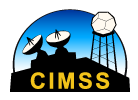On 05 July 2017 a pyroCb formed in Wyoming from the Keystone Fire. GOES-15 detected the smoke plumes and pyroCb cloud, as well as the fires hot spot. The pyroCb cloud (~41.2º N, 106.3ºW) formed around 22:00 UTC . Starting at 20:00 UTC on 05 July, the animation below shows GOES-15 0.63 µm visible (left) and 3.9 µm shortwave IR (right) . In the shortwave IR images, the red pixels indicate very hot IR brightness temperatures exhibited by the fire source regions.

GOES-15 0.63 µm visible channel (left) and 3.9 µm shortwave IR channel images (right) (click to play animation)
In addition, using GOES-15 10.7 μm IR channel the cloud-top IR brightness temperature could be found. The animation below, starting at 0:00 UTC on 06 July, shows the brightness temperature for the pyroCb cloud reaching near -33ºC at 1 UTC (dark green color enhancement). This is brightness temperature does not reach the -40ºC. However, this pyroCb event was confirmed with a better resolution satellite.
A 1-km resolution NOAA-19 AVHRR 10.8 µm Infrared Window image (below;courtesy ofRené Servranckx) revealed a minimum cloud-top IR brightness temperature of -45.7º C (green color enhancement) at 1:06 UTC on 06 July for the pyroCb event.

NOAA-19 AVHRR 0.64 µm visible (top left), 3.7 µm shortwave IR (top right), 10.8 µm IR window (bottom left) and false-color RGB composite image (bottom right)




















